
OER Toolkit for Trades Instructors by Camosun College is licensed under a Creative Commons Attribution 4.0 International License, except where otherwise noted.

OER Toolkit for Trades Instructors by Camosun College is licensed under a Creative Commons Attribution 4.0 International License, except where otherwise noted.
Preamble | Name your Motivation. What is motivating you to incorporate an Open Education Resource (OER) into your teaching and learning practice? Integrating Open Education Resources requires time and consideration, so identifying the benefits is helpful: for example, reduced textbook costs for your students, and/or opportunity to customize a textbook for your course, and/or a chance to work more efficiently by using ancillary resources like a bank of quiz questions or demonstration videos.
Phase 1 | Take stock. How do you currently deliver your course (in the classroom, online, or a combination of the two)? What are your current course resources? (textbook(s), video(s), quiz banks, PowerPoints etc.). Making a list will help you to identify gaps and to understand the difference between a ‘must have’ and ‘nice-to-have’ OER resource. For example, you may decide that your priority is to find an OER quiz bank so you can move away from paper-based assessment.
Phase 2 | Make a plan. Integrating OER into a course can be as simple as adding some quiz questions, or as complicated as transitioning your course to an online format supported by OER resources. Decide what you want to do, and by when.
Making a plan includes asking the right questions. Where do I go in my institution to find the support/resources I need (for example, instructional designers, educational technologists, disability advisors, copyright experts, other instructors who have experience developing online courses and adopting OERs)? Making a plan also includes identifying online sites and resources that will be helpful (for example, websites that focus on, and host, open resources).
Phase 3 | Adopt and Evaluate. Integrate the OERs you have identified as being helpful into your course and keep track of how this worked for you and your students.
The OER Toolkit for Trades Instructors was funded by an OER Grant provided by the B.C. Open Textbook Project.
The B.C. Open Textbook Project began in 2012 with the goal of making post-secondary education in British Columbia more accessible by reducing student cost through the use of openly licensed textbooks and other open educational resources (OER). The B.C. Open Textbook Project is administered by BCcampus and funded by the British Columbia Ministry of Advanced Education and the Hewlett Foundation.
OER, of which this resource is one type, are created and shared in ways so that more people have access to them. This is a different model than traditionally copyrighted materials. OER are defined as “teaching, learning, and research resources that reside in the public domain or have been released under an intellectual property license that permits their free use and re-purposing by others.” (Hewlett Foundation).
At the heart of the open movement lie two central ideas:
Open Educational Resources (OERs) are typically developed by publically-funded educators, who contribute their creations into the public domain using an open license. The nature of these open materials means that anyone can legally and freely copy, use, adapt and re-share them. OERs range from textbooks to curricula, syllabi, lecture notes, assignments, tests, projects, audio, video and animation.
The research shows that OERs not only reduce student debt, they also (when used appropriately in a course) improve student learning.
| Term | Definition |
|---|---|
| Course Delivery Terminology | |
| Blended learning (“Flipped classroom”) | Blended learning is a combination of both face-to-face and online instruction. For example, a student alternates studying in class, with studying independently using Internet-based resources and spaces. |
| Face-to-face | Face-to-face instructional typically occurs in a classroom and that is bound by time, space, and place. |
| LMS (Learning Management System) | An LMS is a software application for the administration, documentation, tracking, reporting and delivery of educational courses or training programs. |
| Licensing & Permissions Terminology | |
| Copyright | Copyright means the sole right to produce or reproduce a work or a substantial part of it in any form. |
| Fair dealing / Fair use | Fair dealing is a user right contained in the Copyright Act (Canada). Fair dealing allows one to copy from a copyrighted work, without the copyright owner’s permission, if the copy is research, private study, education, parody, satire, criticism, review or news reporting; and, the dealing (use) is fair. |
| OER (Open Educational Resource) | Open Educational Resources are “teaching, learning, and research resources that reside in the public domain or have been released under an intellectual property license that permits their free use and repurposing by others.An OER gives instructors and students the legal permission to engage in the “5Rs”.[1] An OER is:
OERs include full courses, course materials, modules, textbooks, streaming videos, tests, software, and any other tools, materials, or techniques used to support access to knowledge.”[2] |
| Open license | This is the “intellectual property license that permits their free use and repurposing by others” that defines a resource as “open”.For example, all new open textbooks added to the BC Open Textbook collection are released under a Creative Commons CC-BY 4.0 International license. With this open license, you are free to:
for any purpose, even commercial. |
| Public domain | The state of belonging or being available to the public as a whole, and therefore not subject to copyright. |
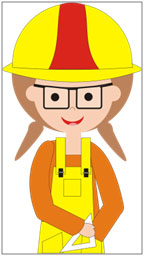
Moira
(CC0 Public Domain)
Meet Moira.
Moira is an instructor in a Trades program at a college in B.C. Since she started working at the college, she has taught all of her courses face-to-face, both in a classroom and on the shop floor. Over the years, Moira has designed and taught her classes around a framework that includes the following:
In summary: Moira’s students acquire their course theory during class lectures and from the course pack. They then go on to have hands-on time in the shop to apply the theory they learned in class and from the course pack readings.
Recently, Moira has been reviewing her course. She has developed a list of recurring issues she wants to address through some course revisions:

Moira
After discussing these concerns with some of her teaching colleagues, Moira feels encouraged to make some significant revisions to her face-to-face course. However, she does not have a lot of time to spare on these revisions; not only will she teach this course again in 3 months but Moira is currently teaching another course and will not have release time to complete her course revisions.
Moira’s goal now is to shift the theory part of her course into a blended delivery format; she will deliver part of the course online and part of it in the classroom. She plans to use her college’s LMS[1] to post readings, her own lecture notes, and videos of practical demonstrations. She believes this will give her students more flexibility in when and where they can review course materials. Moira also hopes that this shift will leave more time in-class for discussions about challenging concepts and preparation for the hands-on time in the shop.
In addition, Moira intends to move all of her self-assessment quizzes into the LMS. Her students will still need to achieve at least 70% to pass the quizzes, but she understands that in the LMS, she can set up the quizzes so students can have more than one attempt to achieve that grade. And she has learned that it’s possible to set these quizzes up so students can receive feedback on their answers as soon as they submit – feedback that could include references back to specific content and readings students should review and can also find in the context of the course site.
Moira has given a lot of thought to the course pack she has been using, especially since hearing from students about the barriers it presents to some of them. Since she will now be using the LMS to support her course, Moira hopes to be able to provide all the instructional materials for the course – including all of the course readings – in a digital format and give her students more flexibility in how they access their content. In her earlier discussions with colleagues about where to begin looking for digital readings and images that she could post to an LMS site, Moira was excited to learn about OERs and the B.C. Open Textbook collection of free textbooks and she began to explore the available titles in the collection. Not only did she discover the collection includes many textbooks geared towards Trades subjects, but she was pleased that she could adopt as much or as little of a textbook as she needed without any concerns about copyright infringement or financial cost to her students.
While Moira is excited to begin implementing her plans for course revisions, she is quickly realizing that she is going to need some help adopting an open textbook and setting up her course site in the LMS. She has created a list of questions and has begun to collect answers from some other Trades instructors with more blended-learning experience. In the process, she is also creating her own list of recommendations for other instructors who may be looking to try something similar.
| Moira’s Questions | Moira’s Planning Notes & Recommendations for Colleagues | |
|---|---|---|
| #1 | Where do I find help at my institution for moving my course into a blended delivery format? | Colleagues at [my college] have recommended that I connect with an instructional designer for advice about moving from a face-to-face to a blended, partially-online format. At [my college], instructional design support is provided through our Teaching & Learning Centre. Speaking of colleagues, I would like to ask a couple of colleagues who have prior experience with any of this process if it’s alright for me to ask for their advice and recommendations when I have questions along the way. |
| #2 | How much time will it take for me to convert my course into a blended format? Do I have enough time to make the revisions I want to make? | I know that 3 months of working “off the side of my desk” does not leave me with a lot of time to complete significant course revisions like this and I understand that I may not have enough time to do everything on my list. I’m dividing my list of priorities into two categories: “must have” by the next time I teach this course and “nice to have” (but may have to wait until I can work on the course again). I will create a 3-month project implementation plan to complete my “must-have” items and will work on any remaining “nice to haves” in the time remaining or at a future date if I run out of time now. “MUST HAVE”
“NICE TO HAVE”
|
| #3 | What LMS does my institution use? Where do I find help at my institution for learning how to use the LMS? (Does this support include help around incorporating selected OERs into my LMS course site?) | I started by talking to some of my colleagues who have experience teaching their courses in a blended format.
|
| #4 | Where do I find help for adopting OERs? (e.g. Open textbooks, open images, ancillary resources) | These are a few “getting started”-type resources I’ve found helpful with the more specific questions I have about OERs:
|
| #5 | Where do I actually find an Open Textbook and then how do I create a copy for my students? Where can I find open images that I can be sure I am allowed to post online for my students? | These are the resources I would recommend my colleagues use to work through the next steps in an open textbook adoption process:
I would definitely recommend that any colleagues who are searching for open-license images use this web service calledCreative Commons Search:
|
| #6 | How do I prepare my students for the online portion of my blended course? | I’ve spoken to an instructional designer and also some of my colleagues about things I can do to prepare my students for the online part of the course. Based on their recommendations, I am planning to:
|
| #7 | Where do students get technical support at my institution for the online portion of my course? | Colleagues have told me to expect that some students will find it challenging at first to use the LMS, and that even those students who have a lot of confidence with technology may need technical assistance on occasion. I have investigated at our college where students can get technical assistance when they are on campus, and I’ve also looked into what technical support they can get when they working in the LMS off-campus. At my college, most students on campus use the Helpdesk run by our IT Services. However, for specific assistance with the LMS, the Helpdesk often redirects students to the Teaching & Learning Centre – since they are the unit that supports the LMS. Based on the recommendations I’ve collected from my colleagues and also from the instructional designer I’m working with, I am planning to:
|
| #8 | Where do students with a learning disability get support (if they need it) at my institution? | In my discussions with colleagues and my instructional designer, I have learned there is a strong possibility that some students in my course may have some type of a learning disability. I have learned that at my college, students who have a disability can connect with our “Disability Resource Centre” if they need some form of assistance or accommodation in support of their needs. I have also learned that some students who have a learning disability are reluctant to tell their instructor due to fears of being stigmatized. I’m concerned that there might be students in my course who, due to some form of learning disability, experience challenges with the LMS or the Open Textbook and don’t tell me about this. Based on what I have learned so far, I am planning to:
|
[1] Examples of popular LMSs currently in use at BC post-secondary institutions include: D2L, Moodle, Sakai, Blackboard.

Moira
Guided by the information she collected during the planning stage, Moira moved forward with her course revisions. With only 3 months before she had to deliver the course again, this is what Moira was able to do to address the key issues she noted in Phase 1 of this guide:
Note: in Moira’s 3-month “Implementation of Planned Revisions” which is described on the following pages:
| Moira’s Tasks (Weeks 1-4) | “Must Have” Goal This Task Supports | Supports Moira Used | |
|---|---|---|---|
| #1 | Connected with 2 colleagues in the Trades school who were willing to share suggestions and recommendations based on their own prior experience with similar course revisions and moving into the LMS. | LMS | Informal “buddy” or mentor system with more experienced “blended delivery” colleagues in Moira’s program. |
| #2 | Met with an instructional designer at the college. | LMS; OT | Instructional Designer Specific to Moira’s college; locate the teaching & learning services at your institution for suggestions. |
| #3 | Booked hands-on training sessions to learn how to use the LMS to:
| LMS | LMS Training & workshops Specific to Moira’s college; locate the teaching & learning services at your institution for suggestions. |
| #4 | Reviewed the “Common Core” section of the “Trades” collection in the BC Open Textbook library | OT | Common Core section of Open Textbook “Trades” collection: https://open.bccampus.ca/find-open-textbooks/?subject=Common Core |
| #5 | Searched this collection for anything that covered “tools and equipment”.
| OT | From the BC Open Textbook Collection: Line C: Tools and Equipment Competency C-4: Describe Ladders and Work Platforms |
| #6 | Read through the textbook and information about the ancillary resources associated with the textbook. [Note: The ancillary resources available with the open textbook Moira adopted included demonstration videos AND a question bank to use for online “self tests”. Moira is free to use all or some of the resources as she likes, and can create new videos and new questions to add to the question bank as her time permits.] | OT | Open Textbook plus ancillary resources: videos, question library. |
| #7 | Downloaded all textbook files + specific ancillary-resource files formatted for Moira’s LMS (D2L) | OT; LMS | Saved to a folder on her own computer at this point. |
| #8 | Filled out and submitted the BC Open Textbook Adoption Form | OT | BC Open Textbook Adoption Form: https://open.bccampus.ca/about-2/adoption-form/ |
| Moira’s recommendation at this point in the project: Check-in with “buddy system” and instructional designer: “How am I doing so far?” | |||
| Moira’s Tasks (Weeks 5-8) | “Must Have” Goal This Task Supports | Supports Moira Used | |
|---|---|---|---|
| #1 | BEFORE STARTING TO USE THE LMS: Using only Microsoft Word, Moira developed a framework or outline of how she would organize information in her LMS site. She wanted to have a clear plan of her online course components in place BEFORE she started working in the LMS. Moira knew that she wanted her LMS site to support a weekly lesson structure, provide quick access to student services information, and give her students access to all of the course materials they needed in order to prepare for classes and to review before taking quizzes and moving into the shop. Using only the technology of Word, Moira decided she would organize her weekly lessons (or “Modules”) and she identified the common components she planned to include in each Module:
| LMS | For this task, Moira used:
Moira’s mock-up in Word of Module structure: |
| #2 | Implemented planned framework in the LMS: Referring to the course site plan she had previously outlined in a Word document, Moira created the structural framework (i.e. Module outlines) for her course in the LMS. | LMS | For this task, Moira used:
Moira’s mock-up in LMS of Module structure: |
| #3 | Uploaded all of the Open Textbook files (textbook chapters + the ancillary video and quiz resources) to the LMS site. | OT; LMS | For this task, Moira used:
|
| #4 | Connected with direct supervisor (Program Chair) to confirm necessary updates to the course description in the institution’s course calendar. Course description modified to include notifications to prospective students so that they would know:
| LMS | Program Chair [Specific to Moira’s college & her program; locate your supervisor for suggestions.] |
| #5 | Connected with the college’s “Disability Resource Centre” for their recommendations about what information Moira should provide to her students about help that is available for students with a disability and how they locate help when and if they need it. | LMS; OT | Disability Resource Centre / Accessibility Services Specific to Moira’s college; locate the accessibility or disability-support services at your institution for suggestions. |
| Moira’s recommendation at this point in the project: Check-in with “buddy system” and instructional designer: “How am I doing so far?” | |||
| Moira’s Tasks (Weeks 9-12) | “Must Have” Goal This Task Supports | Supports Moira Used | |
|---|---|---|---|
| #1 | BUILT OUT THE ONLINE COURSE MODULES: Moira fleshed out the framework she had created in the LMS during Weeks 5-8. She worked through each Module page she had created, and inserted information into each of the sections she had outlined.
| LMS | For this task, Moira used:
|
| #2 | Followed accessibility standards for web content while setting up online content. Based on the recommendations and advice Moira had collected through consultations with an instructional designer, her “buddy system” and with her college’s Disability Resource Centre, Moira understands that if she follows some web accessibility guidelines, she can do a lot to make the content on her course LMS site accessible to all of her students, including students with a disability. | LMS | BC Open Textbook Accessibility Toolkit: https://opentextbc.ca/accessibilitytoolkit/ |
| #3 | Created a “Helpful Resources” section on the homepage of the course site. This section includes short descriptions and links to critical support services that were identified during the Planning stage,:
| LMS | For this task, Moira used:
|
| #4 | Set up a Gradebook in the LMS to more easily track student progress through self-assessment quizzes. During her LMS training, Moira realized that even if she did not have time to create online quizzes to replace the paper-based self-assessments she currently uses, she could at least take advantage of the Gradebook tool to keep track of her students’ progress and opportunities to move on to hands-on time in the shop. Moira was very keen to replace her own paper-based method of tracking this information, and setting up the Gradebook was something she was going to do when she created online quizzes anyway. | LMS (but was also originally listed as a “Nice to Have“) | For this task, Moira used:
|
| #5 | Added selected demonstration videos to the course content. Moira selected several of the available demonstration videos (ancillary resources to the open textbook) and inserted them into the appropriate Modules. | “Nice to have” | Ancillary open-education resources: Videos |
| #6 | Quizzes (An “in-progress” task for Moira at this time) Moira was happy to find that a sizeable question bank was one of the ancillary resources available with the open textbook she adopted. However, with only 3 months to work on her revisions, she ran out of time to review all of the questions and convert all of her self-assessment “quizzes” into an online format. At this point, Moira has set up just a couple of quizzes in her site. Her current plan is to evaluate how her students approach the two online quizzes she has created, and whether or not giving them
helps her students to become better prepared for their hands-on time in the shop. Moira will also administer quizzes through paper hand-outs in class and continue to create more of the LMS-based self-assessment quizzes whenever she has time. | “Nice to have” | Ancillary open-education resources: Question bank |
| #7 | Open-licensed images and photos (An “out-of-scope” task for Moira at this time) As she expected, Moira did not have enough time to search out openly-licensed images to replace the images she had been using (whose copyright permissions were not known to Moira). Moira’s long-term goal is to search for more images online and download only those images that are openly-licensed. In the meantime, Moira has decided not upload any of her current images to the LMS course site unless she is certain she has copyright-clearance to do so. | “Nice to have” | For this task, Moira used:
NOTE from the CC Search service: You should always verify that the work is actually under a CC license by following the link…If you are in doubt you should contact the copyright holder directly, or try to contact the site where you found the content.” |
| Moira’s recommendation at this point in the project: Check-in with “buddy system” and instructional designer: “How am I doing now?” | |||
| #8 | Moira has set aside most of the first face-to-face class to give students a hands-on orientation to the LMS course site and the open textbook | LMS; OT | For this task, Moira used:
|
| And (FINALLY): Moira highly recommends you take a moment at this point to celebrate all your efforts! (You can resume planning for the next phase of your course revisions soon enough.) 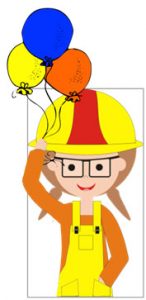 Moira celebrates! | |||
This page includes screen-shots of the first module Moira built in her LMS course site.
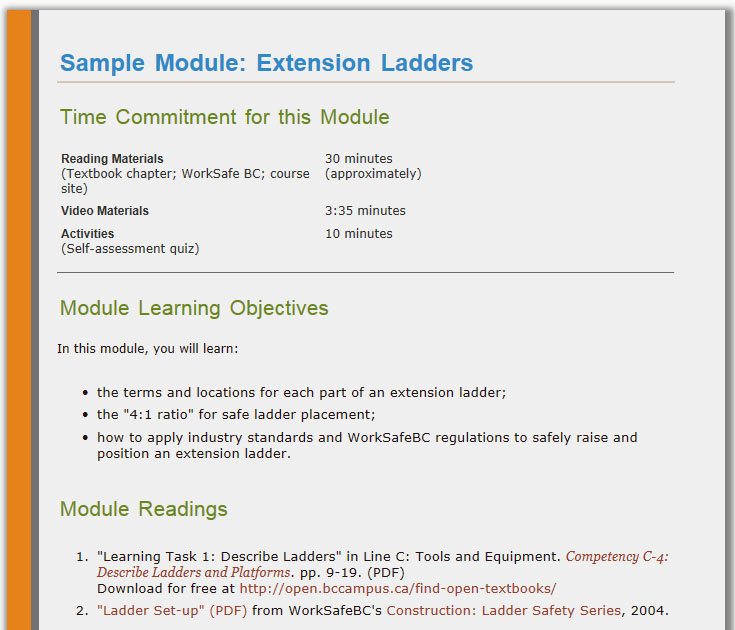
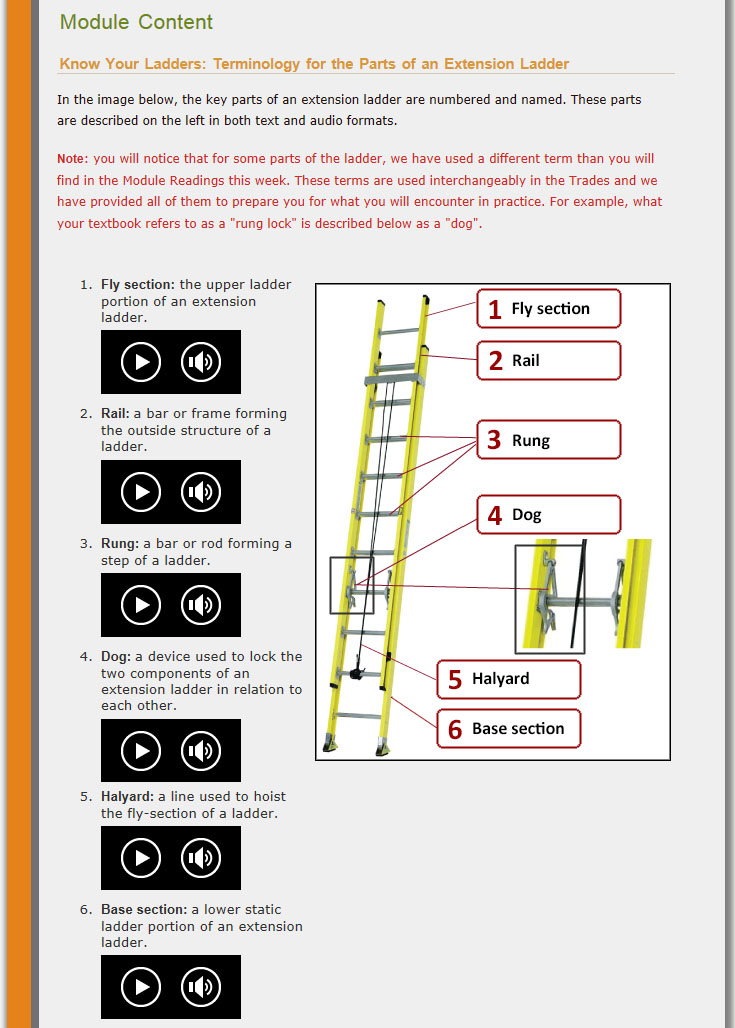
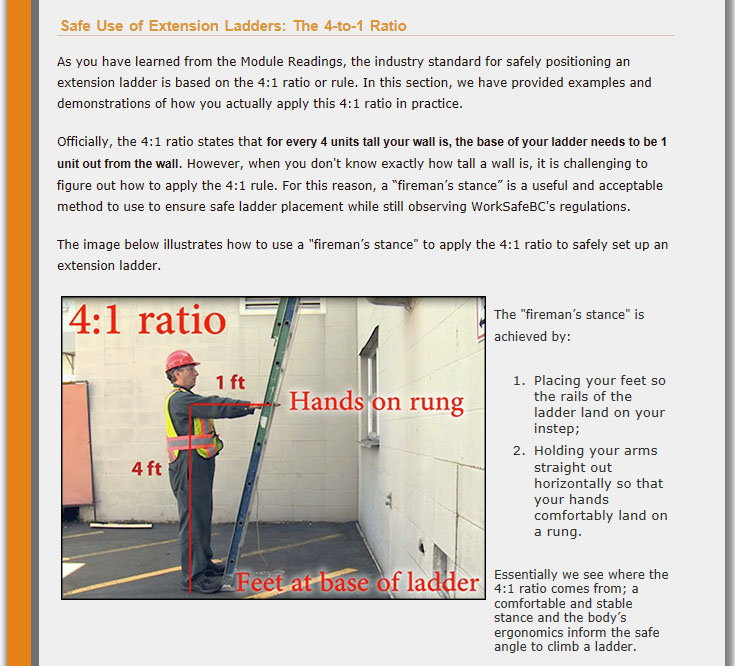
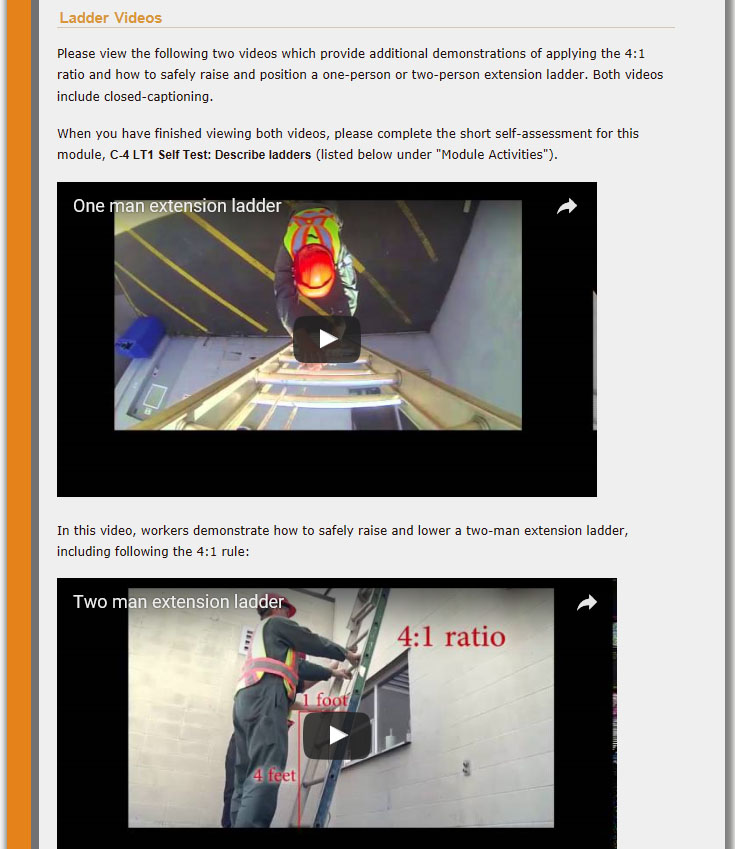
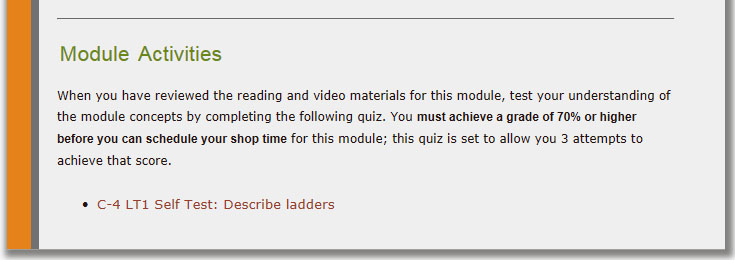
Note: links to external web-based resources listed on this page open in a new browser window.
BCcampus Open Ed “Open Licenses”
https://open.bccampus.ca/open-textbook-101/demystifying-open-licenses/
BCcampus Open Ed “Faculty Guide for Evaluating Open Resources”
https://open.bccampus.ca/files/2014/07/Faculty-Guide-22-Apr-15.pdf
BC Open Textbook Adoption Guide
https://opentextbc.ca/adoptopentextbook/
BCcampus Open Ed – Find Open Textbook
https://open.bccampus.ca/find-open-textbooks/
BC Open Textbook Adoption Guide — “Using an Open Textbook for Your Course”
https://opentextbc.ca/adoptopentextbook/chapter/using-an-open-textbook-for-your-course/
BC Open Textbook Accessibility Toolkit
https://opentextbc.ca/accessibilitytoolkit/
Creative Commons, “About the Licenses”
https://creativecommons.org/licenses/
Creative Commons Search
https://search.creativecommons.org/
Jhangiani, R.S., Pitt, R., Hendricks, C., Key, J., Lalonde, C., (2016) Exploring Faculty Use of Open Education Resources. BCcampus Research Report.
Jhangiani R. & Biswas-Diener R. 2017. Open: The Philosophy and Practices that are Revolutionizing Education and Science. London: Ubiquity Press. DOI: https://doi.org/10.5334/bbc
Lumen Learning, “What’s OER?”
http://lumenlearning.com/about/whats-oer/
Online learning and distance education resources moderated by Tony Bates
https://www.tonybates.ca/tag/open-textbooks/
Tuomi, Ilkka. 2013. Open Educational Resources and the Transformation of Education. European Journal of Education, Vol. 48, No. 1, 2013.
William & Flora Hewlett Foundation, “Open Educational Resources: OER Defined”
http://www.hewlett.org/strategy/open-educational-resources/#overview
BCcampus
Rod Lidstone, Josh Stull, Sarah-Jayne Roe (Camosun College)
With much thanks to the faculty from Trades programs at the following BC post-secondary institutions for contributing input through a needs-assessment survey and follow-up interviews:
Sue Doner & Susan Chandler (eLearning at Camosun College)